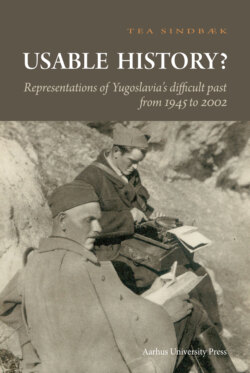Читать книгу Usable History? - Tia Sindbaek - Страница 25
На сайте Литреса книга снята с продажи.
The communist reconstruction of Yugoslavia
ОглавлениеThe Communist Party of Yugoslavia seized power swiftly as the Second World War was ending. Already in 1943, Tito had adopted the title ‘Marshal of Yugoslavia’. In the provisional government established in March 1945 he was both Prime Minister and Minister of Defence. Pretending to cooperate, the communists united with non-communist and pre-war parties within the ‘Popular Front’ (Narodni front), which served as a bogus coalition under strict communist control. In the campaign leading up to the elections of the new constitutional assembly in the Autumn of 1945, hardly any space was left to parties outside the front, and most competitors withdrew. At the elections on the 11th November 1945, the only alternative to supporting the front was to cast a protest vote for an empty list. The Popular Front received an overwhelming majority of votes, approximately 90%, and the Communist Party set out to install itself with hegemonic power.
As highly devoted Stalinists, the Yugoslav communists intended the new Yugoslavia to model that of the Soviet Union. The first post-war constitution, ratified in January 1946, was largely a copy of the Soviet one from 1936. In accordance with the program adopted at the Second AVNOJ meeting in November 1943, and in order to secure the individual nations against internal oppression, Yugoslavia was rebuilt as a federation of six republics, Macedonia, Serbia, Montenegro, Bosnia, Croatia and Slovenia, and within Serbia, which was the largest of the republics, the two autonomous regions Vojvodina and Kosovo. Nevertheless, national relations remained sensitive. To avoid clashes, a law against the incitement of national, racial or religious hatred was passed, and the granting of privileges based on nation, race or religion was prohibited. The republics held considerable cultural autonomy, but they remained under ideological constrains sharply limiting, for example, the praise of national pasts.1
In spite of its formal federalism, the new state was highly centralised with all political power in the hands of the Communist Party leadership; Tito as Secretary General of the party also held the positions of head of government, Minister of Defence, Commander in Chief and head of the Popular Front; Edvard Kardelj was responsible for foreign policy; Milovan Djilas headed the departments for agitation and propaganda; and Aleksandar Ranković was in charge of internal security and the secret police.
Early post-war Yugoslavia was a Stalinist police state.2 An oppressive political security apparatus, the so-called Department for the Protection of the People (Odeljenje za Zaštitu Naroda; OZNA), from 1946 renamed the State Security Administration (Uprava Državne Bezbednosti; UDBa), ensured that all opposition was quietened in a couple of years. Non-communist members of the Popular Front, pre-war politicians and other political opponents were sentenced either to imprisonment with hard labour or death. According to recent estimates, probably tens of thousands were killed by the UDBa in the immediate post-war years, and many more were held in concentration camps.3
The political and economic aims of the Yugoslav communists were similar to those of the Soviet Stalinists and focused on heavy industry and forceful homogenisation of political expression. In 1947, the Yugoslavs introduced the first economic five-year-plan outside the Soviet Union, which was highly ambitious and with a strong focus on industry. Economic reconstruction was boosted, not least by large war reparations. Supported by massive propaganda campaigns and driven by the enthusiastic efforts of communist functionaries and youth brigades, ambitious reconstruction works were realized at impressive speed. When the workforce was lacking in numbers, brigades were sometimes mobilised by force, and at times camp prisoners also assisted in reconstruction projects.4 A cult of leadership was constructed around Tito and the Communist Party, mainly drawing on the history of the National Liberation War.
